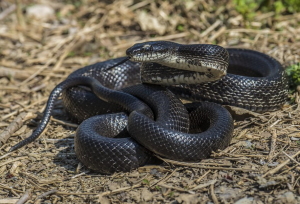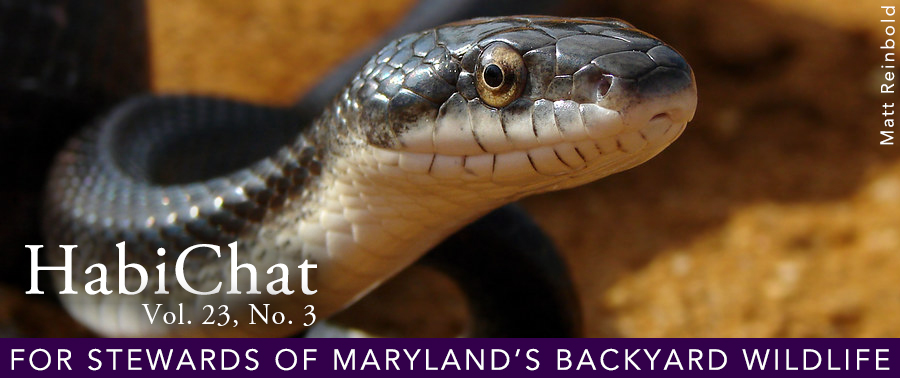Native Animal Profile: Eastern Ratsnake (Pantherophis alleghaniensis)

Adult Eastern Ratsnake by Richard Orr
At one time, I was deathly afraid of snakes, often screeching and running through the forest whenever I encountered a scaly friend. In college, my desire to be a field biologist, coupled with exposure to and knowledge of snakes, helped soften my feelings for them. Over the years, one snake species I have grown particularly fond of is the eastern ratsnake.
The eastern ratsnake is our largest snake in Maryland and is a common visitor in backyards. This species has been recorded at lengths just over eight feet. The eastern ratsnake is a shiny black snake with weakly keeled scales and an irregular black and white checkerboard pattern on the belly. The chin and throat are cream or white in color. Juveniles look very different. They have strongly patterned backs of gray and brown blotches on pale gray. A dark black bar between their eyes extends just past the eye. Males are typically larger than females. North American racers can sometimes be confused with eastern ratsnakes. To compare both species, check out the Common Snakes of Maryland Photo Guide.
Eastern ratsnakes can be found in a variety of habitats, including farmlands, hardwood forests, forested wetlands, isolated urban woodlots and backyards. They do especially well in edge habitats and can climb trees.
As their name suggests, the ratsnake consumes many rodents. Eastern ratsnakes also consume lizards, frogs and birds, as well as their eggs. These snakes have well-developed chemosensory skills that allow them to find prey. This skill often causes eastern ratsnakes to find their way indoors in search of rodents.
Males reach sexual maturity around seven years of age, while females reach sexual maturity around nine years of age. Breeding season runs May through June. During this time, males seek out potential mates and will sometimes travel a bit to find them. Females will lay eggs in early to mid-July in clutches of 5-19 eggs at a time. Females use almost one third of their body mass to lay eggs and the number of eggs laid is directly proportional to the size of the female. The eggs will hatch in 37-51 days and the juveniles do not require parental care.

Juvenile Eastern Ratsnake by Robert Warren
Eastern ratsnakes, when startled, will sometimes assume a rippled appearance that is believed to help them get away from danger faster. In addition, some will curl up and rapidly flick their tail on leaves to mimic venomous timber rattlesnakes. Eastern ratsnakes will also inflate their heads to mimic venomous snakes. In rare cases, eastern ratsnakes will coil into an s-shaped ball and will hiss and strike. Ratsnakes will bite if provoked, but they are not venomous.
Eastern ratsnakes are quite common in many backyards as long as ample cover and food is available. They are very beneficial, consuming not only rodents but also ticks found on the rodents, decreasing populations of these pests. Shelter sites include moist areas under logs and rocks, as well as sunny basking areas on warm surfaces. Sometimes, unattended mulch or compost piles will be used for egg laying sites, as will hollow logs. These snakes will occasionally raid bird houses that do not contain proper predator guards. Therefore, it is always important to include predator guards and baffles that will exclude snakes, unless you want them to catch an easy meal. (They have to eat too!). Their propensity for consuming rodents such as mice and voles make the eastern ratsnake a very beneficial backyard predator.
References:
Virginia Herpetological Society. 2019. https://www.virginiaherpetologicalsociety.com Accessed May 24, 2019.
Wray, P. 2003. Black Rat Snake. https://www.psu.edu/dept/nkbiology/naturetrail/speciespages/blackratsnake.htm Accessed May 24, 2019.
Welcome to Summer!
It seems like spring has quickly blossomed into summer! We are now in peak bloom time for many local plant species, as well as peak activity for local wildlife.
In this issue of HabiChat, you can learn about a lovely group of perennial flowers known as mountain mints, as well as a common backyard snake – the eastern ratsnake. In addition, thanks to Rod Simmons, Natural Resource Manager and Plant Ecologist with the City of Alexandria, I have included a short article on alternatives to traditional lawn.
I am also excited to announce a new Common Snakes of Maryland Photo Guide which covers twelve of the most commonly seen snakes in the state. I also have been busy updating our Snakes of Maryland pages to reflect recent changes in taxonomy.
As summer ripens, check out some of our previous HabiChat articles on topics such as Xeriscaping, Minimizing Pesticide Impacts to Pollinators or Growing Your Own Seed. Don’t forget to add water to your landscapes as well! Finally, keep in mind that deer are currently giving birth. For questions regarding fawns, check out our Deer Fawn page.
Happy Habitats,
Kerry Wixted
Click here to have HabiChat—the quarterly backyard wildlife habitat newsletter from the Wild Acres program—delivered right to your inbox!
In this Issue
Habitat Tips: Lawn Alternatives
Native Animal Profile: Eastern Ratsnake
Native Plant Profile: Mountain Mint


 1-888-373-7888
1-888-373-7888 233733
233733